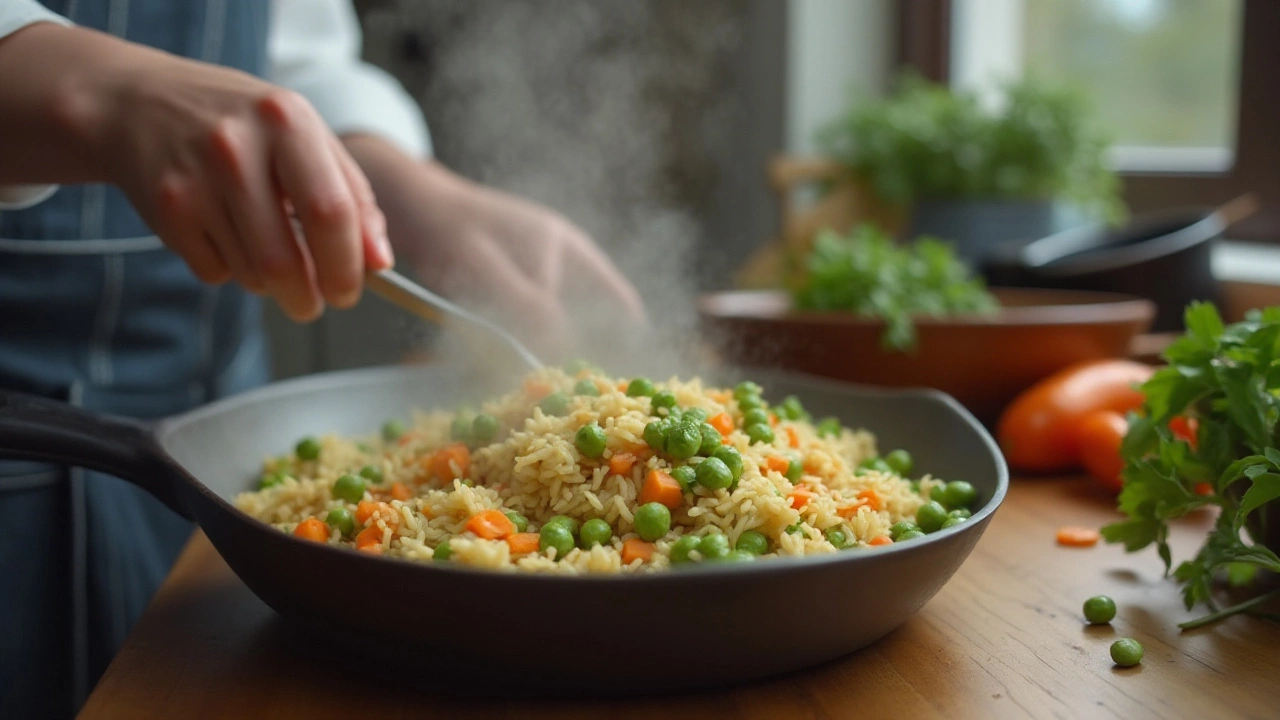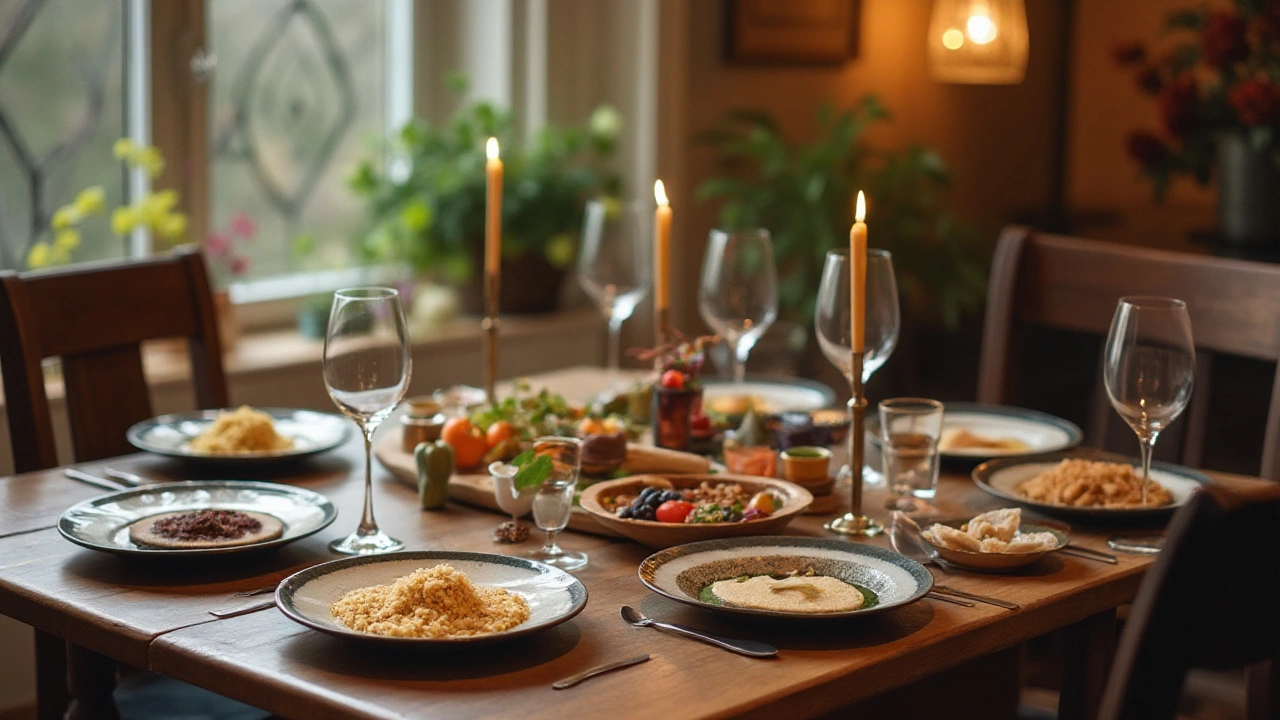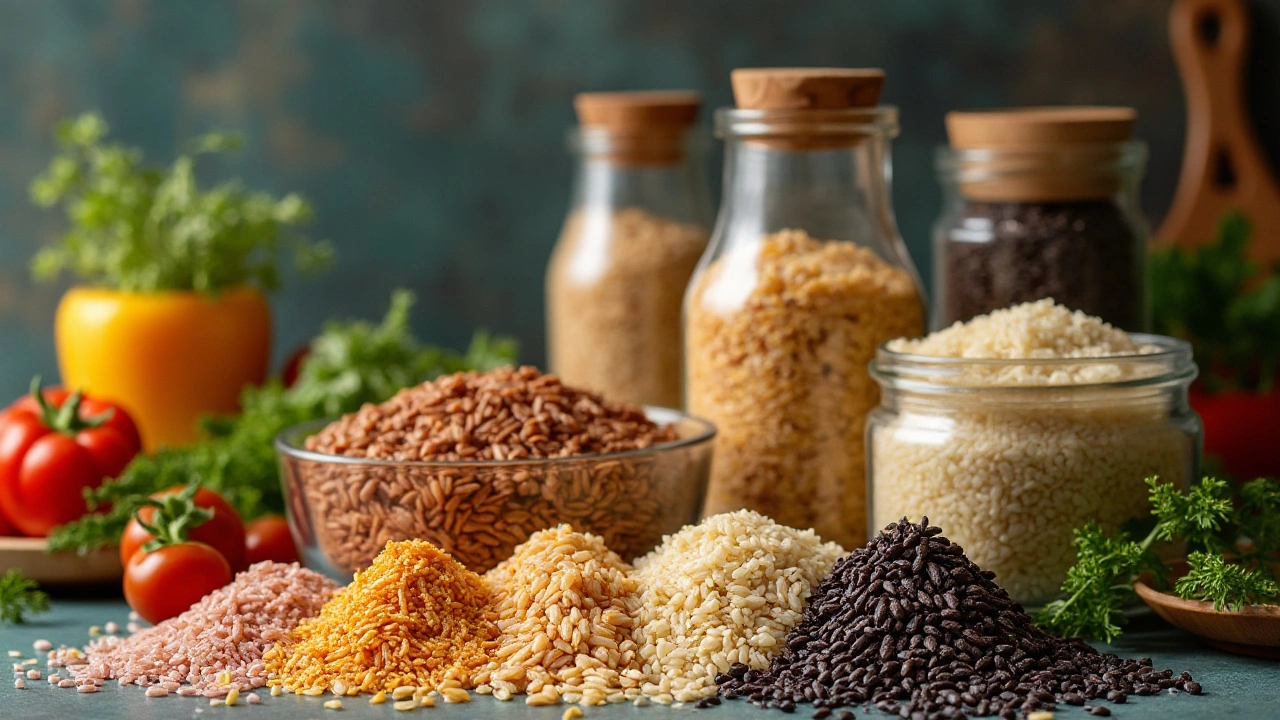Rice, a staple food for millions worldwide, plays a remarkable role in vegan diets, providing flavor, texture, and essential nutrients. With a myriad of rice varieties at one's disposal, each brings something unique to the table, making it a versatile ingredient for countless recipes. Vegans find themselves pondering over which rice to integrate into their meals to meet both culinary desires and nutritional needs.
In this exploration, we'll dive into the world of rice, uncovering the best options for those embracing a plant-based lifestyle. From the richness of whole grain brown rice to the delightful aroma of jasmine, each kind offers its charm and benefits. Join us in uncovering the nutritional secrets and culinary potential of these rice varieties, ensuring your vegan meals are both delicious and wholesome.
- Types of Vegan-Friendly Rice
- Nutritional Benefits
- Cooking Tips and Techniques
- Delicious Vegan Rice Recipes
Types of Vegan-Friendly Rice
In the diverse world of vegan cooking, rice emerges as a hero ingredient, known for both its diversity and nutritional prowess. Vegan rice varieties offer an abundance of choices, each with its distinctive taste, texture, and preparation method. Brown rice stands out notably for vegans, praised for its rich, nutty flavor and intact bran layer that retains most of its nutrients. It's an ideal option for those mindful of maintaining a healthy diet while being eco-conscious. Subtly sweet and pleasantly chewy, it provides satiety without weighing the eater down, making it a cornerstone in many plant-based meals. Despite a longer cooking time, its nutritional payoff is substantial as it delivers an impressive amount of fiber and magnesium.
Then there's the fragrant basmati rice, often celebrated for its delicate aroma and light, fluffy texture. While traditionally linked to Indian and Middle Eastern cuisines, it has found its way into a myriad of vegan dishes globally. Known to pair exceptionally well with spices like cumin and cardamom, basmati adds an extra layer of flavor to any meal while still being gentle on the palate. This long-grain variety cooks up nicely without sticking together, making it perfect for dishes that require each grain to stand independently, such as pilafs or salads.
Jasmine rice, another long-grain favorite with a wonderful fragrant aroma, graces the plates of vegan chefs with its slightly sticky texture, making it an excellent companion for Southeast Asian meals. Its floral scent creates an inviting dining experience, while its softness complements a variety of sauces, making each bite a delight. Jasmine rice, with its enchanting fragrance, finds its way into many vegan curries and stir-fries, enhancing the taste without overpowering the dish. This type of rice is not just pleasant to eat but also easy to digest, a comforting option for anyone seeking to blend comfort with culinary artistry.
For vegans with a penchant for unique flavors, we have the exotic black rice, often dubbed "forbidden rice" dating back to ancient China, where it was reserved for royalty. Its dark color indicates high levels of anthocyanins, the same antioxidants found in blueberries, which contribute to its health benefits. Black rice cooks to a beautiful deep purple and has a sweet, chewy texture that adds richness to dishes. In addition to its visual appeal, it packs a nutritional punch with higher protein and iron content compared to other rice types, making it an excellent choice for fortifying vegan diets.
The varied world of rice caters to the versatile needs and preferences of vegans, ensuring meals that are both nourishing and satisfying. Each rice type brings its own set of distinctive features. By knowing the special characteristics of each, vegans can skillfully select the right type of rice to elevate their dishes and embrace a plant-based diet while enjoying sumptuous flavors and vibrant textures.

Nutritional Benefits
Rice is not only a culinary delight but a nutritional powerhouse for vegans, offering a range of essential nutrients that are crucial for a balanced diet. When we dive into the world of rice, it's important to understand what each type brings to the table in terms of nutritional advantages. Brown rice, for example, is often hailed for its higher fiber content and numerous vitamins and minerals. Unlike white rice, brown rice retains its bran and germ, which are rich in essential nutrients like magnesium, manganese, and vitamin B6. This makes it a superb choice for those on a plant-based diet who need to meet their daily nutritional requirements.
Beyond fiber, rice varieties such as wild rice are known for their impressive protein content compared to other grains. Protein is a vital nutrient that aids in muscle repair and growth, as well as providing energy. For vegans, incorporating enough protein into their meals can sometimes be a challenge, and wild rice emerges as a secret weapon in tackling this concern. A cup of cooked wild rice can pack nearly 7 grams of protein, which is a significant contribution to a plant-based diet aiming for adequate protein intake.
Among the more exotic options, black rice is becoming increasingly popular due to its high antioxidant properties, akin to those found in blueberries. Its dark purple hue is not only visually appealing but indicates the presence of anthocyanins, which are beneficial compounds known to combat oxidative stress and reduce inflammation in the body. This unique type of rice provides a boost to the immune system, making it a fantastic option for keeping your health in check.
"The nutritional diversity in rice varieties presents an unparalleled opportunity for vegans to not only enjoy delicious meals but also to fortify their diet with essential nutrients," says Dr. Nina Roberts, a well-known nutritionist specializing in plant-based diets.
Interestingly, some rice varieties can also contribute to heart health. Basmati rice, particularly when in its whole grain form, has a low glycemic index. This means it causes a slower, steadier release of glucose into the bloodstream, aiding in maintaining stable blood sugar levels. Such properties are beneficial for those watching their carbohydrate intake or managing conditions like diabetes. The benefits extend beyond blood sugar control, as the fibers and nutrients found in basmati rice support healthy cholesterol levels, thus benefiting cardiovascular health.
To help you better understand the nutritional content of various rice varieties, here’s a comparison of their typical fiber and protein content:
| Rice Type | Fiber (per 100g) | Protein (per 100g) |
|---|---|---|
| Brown Rice | 3.5g | 2.6g |
| Wild Rice | 1.8g | 4.0g |
| Black Rice | 3.2g | 8.5g |
Incorporating a variety of rice types into your meals ensures a wide spectrum of these nutritional benefits. A vegan diet, while restricted in certain food groups, can be rich in taste and nutrition when one takes advantage of the diversity and strengths each type of rice offers. Whether it's boosting your protein intake, ensuring you get plenty of fiber, or indulging in the benefits of antioxidants, there's a rice variety to match your health goals and culinary preferences.

Cooking Tips and Techniques
Cooking rice might seem like a simple task, but achieving the perfect texture and flavor can be an art form, especially when incorporating various rice types into a vegan recipe. Each variety of rice requires precise attention to details like water ratio, cooking time, and pre-treatment to release its full culinary potential. A mindful approach can elevate any dish from ordinary to spectacular, turning rice into the true star of a plant-based diet.
For starters, the key to cooking fluffy brown rice, which is a popular choice among vegans due to its nutty flavor and high fiber content, lies in its soaking process. Soaking the rice for at least 30 minutes before cooking allows the grains to soften and cook evenly. An equal ratio of rice to water, with a dash of salt, is perfect for achieving a light, fluffy texture. Bring the mixture to a boil, then reduce the heat and let it simmer with a lid on for about 40 to 45 minutes. Remember to let it sit after cooking, covered, to allow the steam to finish the job without burning.
Jasmine rice, on the other hand, requires a gentle touch. Known for its fragrance and soft consistency, it can clump together easily if not handled correctly. Rinsing jasmine rice is essential to remove excess starch that can lead to stickiness. The secret is in the boiling method: using a one-to-one-and-a-half ratio of rice to water, bring it to a boil, then reduce the heat to low and cover it. Cook it for 10 to 15 minutes, then remove from heat and let it rest, untouched, for 10 more minutes to ensure the grains set properly. Precision is key; too much water can make it mushy, compromising its aromatic qualities.
Basmati rice, celebrated for its long, slender grains, also deserves attention. This rice benefits from a rinsing process similar to jasmine, but the water ratio is crucial. A common approach is using one part rice to two parts water. Bring the water to a rolling boil before adding the rice, then cook on high heat until you see steam holes on the surface, signaling it's time to lower the heat. Cover with a tight lid and cook on a low flame for the perfect fluffy result. Allow cooling for several minutes before fluffing with a fork to add that airy texture.
Black or forbidden rice, packed with antioxidants and a unique nutty taste, offers an adventurous choice for vegan meals. Its deep, rich color enhances any dish, both visually and nutritionally. Black rice has a lower glycemic index than white rice, making it perfect for health-conscious vegans. It requires a longer cooking time, usually soaking for several hours or overnight is recommended to expedite this process. Use two cups of water for each cup of rice, bring to boil, then simmer it covered for about 30 to 35 minutes until tender. Let it sit off heat to absorb any remaining moisture, ensuring the grains remain intact and flavorful.
"Cooking is not about following a recipe, it's about exploring the ingredients and their potential," reflects Samin Nosrat, a culinary expert renowned for her insightful approach to the art of cooking. Her perspective resonates deeply when it comes to preparing rice, as each type brings out the chef's unique palette, inspiring creativity in everyday vegan recipes.
Lastly, regardless of the type of rice you are cooking, one universal tip is avoiding the temptation to lift the lid frequently. Each time the lid is removed, precious steam escapes, which is crucial for proper rice cooking. Leave it untouched during its resting period to allow the carry-over heat to work its magic, resulting in perfectly cooked rice every time. By adopting the right techniques for different rice varieties, vegan enthusiasts can enjoy diverse, wholesome meals brimming with flavor and nutrition.

Delicious Vegan Rice Recipes
The world of vegan recipes is vibrant and full of creativity, and nothing embodies this better than dishes centered around humble rice. As a staple, rice acts both as a canvas and a companion, ready to absorb and enhance whatever flavors you choose to pair with it. It's no wonder that many cultures have rice at the heart of their culinary traditions, offering inspiration for delightful vegan creations at home. Whether it’s a comforting bowl of risotto, a fragrant biryani, or a simple stir-fry, the versatility of rice in vegan cooking knows no bounds.
Consider starting with a hearty vegan paella. This Spanish-inspired dish substitutes traditional seafood and meats with a medley of colorful vegetables and legumes. Begin by sauteing onions, garlic, and bell peppers until they're soft, then add chopped tomatoes to create a rich base. Incorporate green beans, peas, and artichokes for a burst of nutrition and texture. Add smoked paprika, saffron, and a generous squeeze of lemon juice, creating a symphony of flavors reminiscent of sunny Spanish shores. To complete the meal, stir in your favorite type of rice, allowing it to cook until it absorbs all those delicious juices. The result is a vibrant dish that satisfies both the eyes and the palate.
Next, we have coconut curry rice, a dish that uses the rich creaminess of coconut milk to elevate simple ingredients into a feast. Start by heating a pan with a bit of coconut oil, then add garlic, ginger, and turmeric, letting their aromas fill your kitchen. Toss in diced sweet potatoes and red lentils, stirring well to coat them in the spices. Add the rice of your choice, and pour in coconut milk and vegetable broth. Let the mixture simmer on low heat, allowing the flavors to meld and the rice to become wonderfully tender. This dish not only teems with flavors but is also packed with essential nutrients, offering the benefits of healthy fats and plant-based protein.
Cynthia Sass, a renowned nutritionist, once said, "Rice is a wonderful platform to build flavors; it brings the best out of ingredients with its simplicity and subtlety."
If you're looking for something quicker yet equally delicious, consider a stir-fry. Begin by sautéing tofu cubes until golden brown, and then add an assortment of your preferred vegetables such as broccoli, carrots, and bell peppers. Use tamari or soy sauce, a hint of sesame oil, and a splash of lime juice to create a delightful sauce that ties everything together. Toss in cooked jasmine or basmati rice, and stir everything together until heated through. This quick and satisfying meal reflects the brilliant adaptability of rice and the convenience of Asian-inspired cuisine.
Finally, dessert rice pudding offers a sweet twist on this staple. Mix cooked jasmine rice with almond milk, vanilla extract, cinnamon, and a dash of nutmeg. Stir in a handful of raisins or sliced almonds, then let everything simmer until the pudding thickens to your liking. This comforting and creamy delight makes for the perfect ending to any meal, proving that rice can satisfy a sweet tooth too.
The possibilities with vegan rice recipes are truly endless. With each dish, not only are you exploring new flavors and textures, but you are also incorporating a vital nutrient-rich ingredient into your diet. Happy cooking!

